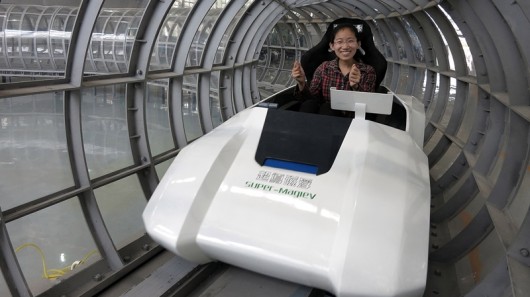Scientists build super-maglev train that could hit 1,800 mph
By Stu Robarts
May 23, 2014

A team lead by Dr Deng Zigang at Southwest Jiaotong University in China have built a maglev train with the potential to reach 1,800 mph (2,900 km/h) (Photo: Imagechina)
Scientists at Southwest Jiaotong University in China have reportedly built a maglev train that could reach 1,800 mph (2,900 km/h). According to The Daily Mail, a vacuum is used to minimize air resistance. Project lead Dr Deng Zigang claims it could be used for military or space launch systems.
Maglev trains use electromagnetism to lift the train off a track and to provide propulsion. By removing the need for contact with a surface via wheels, friction is substantially reduced and speed can be increased. They are also smoother to ride than surface-supported alternatives and are less affected by the weather.
The current fastest passenger-carrying maglev train can travel at up to 268 mph (431 km/h) and once reached 311 mph (501 km/h) in pre-launch tests. The Shanghai Maglev Train opened in April 2004 and runs 18.95 miles (30.5 km) from the center of the Pudong district of Shanghai to Shanghai Pudong International Airport.
At those sort of speeds, air resistance becomes a serious issue. The Mail article cites a paper by Zigang in which he writes, "If the running speed exceeds 400 kilometers (250 miles) per hour, more than 83 percent of traction energy will wastefully dissipate in air resistance."
The idea of running a maglev train in a vacuum, therefore, seems a logical one. It would increase its potential top speed and improve its energy efficiency. This principle is the same as the one that the Evacuated Tube Transport is based, which could theoretically transport people between new York and Beijing in 2 hours.
Elon Musk's proposed Hyperloop, meanwhile, isn't thought to use a vacuum to reduce air resistance, but will still potentially max out at 760 mph (1,220 km/h). Zigang's concept would leave even that in its dust.
In developing the train, Zigang first had to create a small, remote-controlled ring-line version of the system on which the maglev vehicle could accelerate to 15 mph (25 km/h). That was achieved in February last year, after which an evacuation tube was added to create an internal vacuum.
With the vacuum created, the vehicle was reportedly able to accelerate to a maximum speed of 30 mph (50 km/h). The prototype was, of course, run without passenger and was limited by the small 6 m (20 ft) radius of the ring guideway.
"The meaning of the project is that it will be the first one to realize the prototype of the future evacuation tube transportation," The Daily Mail reports Zigang as saying. "At this moment, we are conducting evacuation tests on the new system. We will release our achievements after the successful running in the near future."
Source: Daily Mail
Copyright © Gizmag 2003 - 2014

